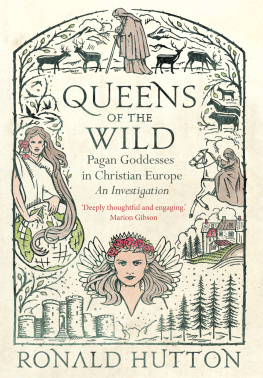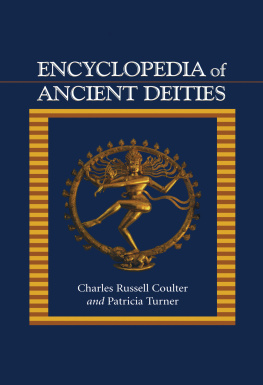Praise for Encyclopedia of Goddesses and Heroines
Patricia Monaghan is deeply missed by her colleagues, friends, and students; this new edition of her marvelous Encyclopedia of Goddesses and Heroines is a fitting memorial to her lifelong contribution in the field of womens spirituality and goddess scholarship. This book is a rich resource and a valuable asset for investigators looking into the ancient worldwide tradition of goddess veneration. Who knew She had so many names?
Vicki Noble, cocreator of the Motherpeace Tarot deck and author of Shakti Woman
This introductory overview of historical goddesses worldwide is a much-needed correction to the androcentric biases that still skew our sense of religion. Im grateful to Patricia Monaghan for researching and composing this rich history of spiritual abundance.
Charlene Spretnak, author of Lost Goddesses of Early Greece
I count Patricia Monaghan as one of the illustrious ancestors of the global womens spirituality movement. The Encyclopedia of Goddesses and Heroines first came onto the literary scene at a time when most people knew little about the feminine face of the divine and almost nothing about the myths and rituals of African people. Patricias book gives us the names and definitions that make it possible to embrace goddesses from cultures around the world. A new generation of students and artists will reap the benefit of her legacy.
Yeye Luisah Teish, author of Jambalaya: The Natural Womans Book of Personal Charms and Practical Rituals
Praise for Patricia Monaghans The Red-Haired Girl from the Bog
A rich, beautiful story of a nearly forgotten world Myth, tale, and tradition are brought to light and burnished in an engaging style. The world of women, the goddess, and feminine power all shine through.
Leonard Shlain, author of The Alphabet Versus the Goddess
Few stories are as fascinating as this story of a return to Ireland, the land of primordial enchantment. Its amazing to find someone who presents so well the people and places, the myths, realities, and history of this country.
Thomas Berry, author of The Dream of the Earth and The Great Work
Patricia Monaghan daringly braids past and present together on her inspirational pilgrimage to Irelands mythic sites.
Caitln Matthews, author of The Celtic Spirit

ALSO BY PATRICIA MONAGHAN
Dancing with Chaos
Encyclopedia of Celtic Myth and Folklore
Meditation The Complete Guide (with Eleanor G. Viereck)
The Goddess Companion
Goddesses in World Culture
The Goddess Path
Grace of Ancient Land
Homefront
Magical Gardens: Cultivating Soil and Spirit
The Red-Haired Girl from the Bog: The Landscape of Celtic Myth and Spirit
Seasons of the Witch


Copyright 2014 by Patricia Monaghan
All rights reserved. This book may not be reproduced in whole or in part, stored in a retrieval system, or transmitted in any form or by any meanselectronic, mechanical, or otherwithout written permission from the publisher, except by a reviewer, who may quote brief passages in a review.
Encyclopedia of Goddesses and Heroines, 2 Volumes, by Patricia Monaghan, was originally published in hardcover by Greenwood, an imprint of ABC-CLIO, LLC, Santa Barbara, CA. Copyright 2009 by Patricia Monaghan. Condensed ebook edition by arrangement with ABC-CLIO, LLC, Santa Barbara, CA. All rights reserved.
Text design by Tona Pearce Myers
Library of Congress Cataloging-in-Publication Data
Monaghan, Patricia.
Encyclopedia of goddesses and heroines / Patricia Monaghan. Revised Edition.
pages cm
Includes bibliographical references and index.
ISBN 978-1-60868-217-1 (pbk. : alk. paper) ISBN 978-1-60868-218-8 (ebook)
1. GoddessesEncyclopedias. 2. Women heroesEncyclopedias. I. Title.
BL473.5.M663 2014
First printing, April 2014
ISBN 978-1-60868-217-1
Printed in Canada on 100% postconsumer-waste recycled paper

| New World Library is proud to be a Gold Certified Environmentally Responsible Publisher. Publisher certification awarded by Green Press Initiative. www.greenpressinitiative.org |
10 9 8 7 6 5 4 3 2 1

I n 2008, archaeologists in Germany made a startling discovery. In Swabian Jura, where caves in limestone cliffs sheltered ancient humans, a figurine was unearthed from rubble. Carved from mammoth ivory, the figure showed a naked woman. Such figures have been found before where this Venus emerged, for the figure found in Hohle Fels Cave was named for a Roman goddess, as has been common since these figures were first discovered more than a century ago. In Austria (Willendorf and Galgenberg), France (Brassempouy, Laussel), and other European sites (Doln Vstonice in the Czech Republic, Moravany in Slovakia, Monruz in Switzerland, Malta in Russia), archaeologists have found tiny figures of naked women. They are among the most ancient artworks of humanity, carved from stone or bone or molded from clay between twenty and thirty thousand years ago.
That long ago, during the Paleolithic Era, humans lived in small groups hunting and gathering foods. Recent studies suggest a large proportion, up to 80 percent, of their diet came from plant foods like berries, fruits, and roots, which scholars assume were gathered by women. Meat, while providing necessary nutrients, was less readily available and required significant strength and skill to acquire, and it is presumed hunting was a predominantly male occupation, although women may have trapped small mammals and caught fish. What distinguishes this period of human history from earlier ones is that for the first time humans began to use stone tools. This revolution led to others, such as the establishment of year-round villages and the invention of art.
What knowledge we have of these ancestors comes from scanty traces of their daily lives. Only material resistant to decay survives the millennia: bone, stone, fired clay. We have no way of knowing how ancient humans dressed or what footwear they favored. We have no Paleolithic fishing nets or traps, no spears, no baskets. We do not know how they organized their societies or traced their descent lines. We have no idea what languages they used. But because they carved bone and painted on stone, we can see and appreciate their art.
The cave paintings at Lascaux and Pech-Merle in France show that these ancient humans had a sophisticated sense of beauty and a command of painterly techniques. In Lascaux, animals leap and prance around the walls and roof of a series of interlocking caves. At Pech-Merle, spotted horses and woolly mammoths adorn the walls, and the outline of a hand suggests the presence of the artist. In addition to such painted galleries, we have dozens of examples of Paleolithic portable art in the form of expressive incised drawings of animals on bone and delicate carvings of Venus figurines.
Next page
















